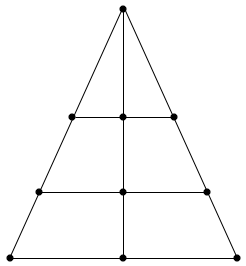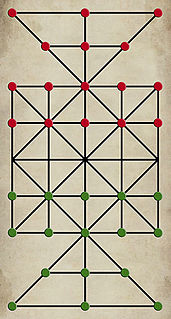Related Research Articles
Fox games are a category of asymmetric board games for two players, where one player is the fox and tries to eat the geese / sheep, and the opposing player directs the geese/sheep and attempts to trap the fox, or reach a destination on the board. In another variant, Fox and Hounds, the fox merely tries to evade the hounds. There are several versions known:
Rimau-rimau is a two-player abstract strategy board game that belongs to the hunt game family. This family includes games like Bagh-Chal, Main Tapal Empat, Aadu puli attam, Catch the Hare, Sua Ghin Gnua, the Fox games, Buga-shadara, and many more. Rimau-rimau is the plural of rimau which is an abbreviation of the word harimau, meaning 'tiger' in the Malay language. Therefore, rimau-rimau means 'tigers'. The several hunters attempting to surround and immobilize the tigers are called orang-orang, which is the plural of orang, meaning 'man'. Therefore, orang-orang means 'men' and there are twenty-two or twenty-four of them, depending on which version of the game is played. The game originates from Malaysia.
Main tapal empat is a two-player abstract strategy board game from Malaysia. It is a hunt game, and specifically a tiger hunt game since it uses an Alquerque board. The tigers can move as many spaces in a straight line as a clear path allows. Most hunt games have tigers, leopards, or foxes moving only one space at a time. In effect, the tigers in this game have the movement capability of the queen in chess.

Lau kata kati is a two-player abstract strategy game from India, specifically from Lower Bengal, and also from United Provinces, Karwi Subdivision where it is called Kowwu Dunki, and it was described by H.J.R. Murray in A History of Board-Games Other Than Chess (1952). The game is related to draughts and even more so to Alquerque. Pieces are captured by leaping over them. The board is a pattern of two triangles joined together at a common vertex with further lines subdividing them. It is the same game as Butterfly (game) from Mozambique, which suggests a historical connection between the two games. Lau kata kati belongs to a specific category of games called Indian War-games, and the other games in this category are Dash-guti, Egara-guti, Pretwa, Gol-skuish. All Indian War-games have one important thing in common, and that is that all the pieces are laid out on the patterned board, with only one vacant point in the center. This forces the first move to be played on the central point, and captured by the other player's piece.
Dash-guti is a two-player abstract strategy board game from India, specifically from Central Provinces, United Provinces, Karwi Subdivision where it is called Kowwu Dunki which is the same name given to another similar game called Lau kata kati, and it was described by H.J.R. Murray in A History of Board-Games Other Than Chess (1952). The game is related to Draughts and even more so to Alquerque. Pieces are captured by leaping over them. Dash-guti consists of a Lau kata kati board, but with the addition of two line segments connected to the vertex but exterior to both triangles. Dash-guti belongs to a specific category of games called Indian War-games, and the other games in this category are Lau kata kati, Egara-guti, Pretwa, Gol-skuish. All Indian War-games have one important thing in common, and that is that all the pieces are laid out on the grid patterned board, with only one vacant point in the centre. This forces the first move to be played on the central point, and captured by the other player's piece.
Egara-guti is a two-player abstract strategy game from India, specifically from Central Provinces, and it was described by H.J.R. Murray in A History of Board-Games Other Than Chess (1952). The game is related to Draughts and even more so to Alquerque. Pieces are captured by leaping over them. Egara-Guti consists of a Lau kata kati board, but with the addition of two lines connecting the two triangles and running through them. Egara-guti belongs to a specific category of games called Indian War-games, and the other games in this category are Lau kata kati, Dash-guti, Pretwa, Gol-skuish. All Indian War-games have one important thing in common, and that is that all the pieces are laid out on the grid patterned board in the beginning, with only one vacant point in the center. This forces the first move to be played on the central point, and captured by the other player's piece.
Tsoro Yematatu is a two-player abstract strategy game from Zimbabwe. Players first drop their three pieces onto the board, and then move them to create a 3 in-a-row which wins the game. It is similar to games like Tapatan, Achi, Nine Holes, Shisima, and Tant Fant. However, what makes this game unique is that pieces can jump over each other which adds an extra dimension in the maneuverability of the pieces.
Hare games are two-player abstract strategy board games that were popular in medieval northern Europe up until the 19th century. In this game, a hare is trying to get past three dogs who are trying to surround it and trap it. The three dogs are represented by three pieces which normally start on one end of the board, and the hare is represented by one piece that usually starts in the middle of the board or is dropped on any vacant point in the beginning of the game.

Peralikatuma is a two-player abstract strategy board game from Sri Lanka. It is a game related to draughts (checkers) and Alquerque as players hop over one another's pieces when capturing them. The game was documented by Henry Parker in Ancient Ceylon: An Account of the Aborigines and of Part of the Early Civilisation (1909) with the name Perali Kotuwa or the War Enclosure. Parker mentions that it is also played in India. It closely resembles another game from Sri Lanka called Kotu Ellima. The two games use the same board which consist of a standard Alquerque board but with four triangular boards attach to its four sides. The only difference between the two games is in the number of pieces. In Peralikatuma, each player has 23 pieces. In Kotu Ellima, each player has 24 pieces.
Rimau is a two-player abstract strategy board game from Malaysia. It is a hunt game, and specifically a tiger hunt game since it uses an expanded Alquerque board. The one tiger is being hunted by 24 men. The tiger attempts to eat the men, and the men attempt to trap the tiger. An interesting feature in this game is that the tiger can capture a line of men in a single leap. There must be an odd number of men in the line, and they must be adjacent to one another. In most hunt games, the tiger, leopard, or fox is only able to capture one prey in a leap.

Buga-shadara, also known as Bouge Shodre, is a two-player abstract strategy board game from Tuva, a republic in Siberia, Russia. It is a hunt game where one player plays the deer. There are two deer usually represented as the black pieces. The boars are also referred black in the referenced article "Buga-shadara a folk game from Tuva". The other player has 24 white pieces with dogs associated to them. The board consist of an Alquerque board flanked on two of its opposite sides by a square patterned board. Because the board is in part an Alquerque board, this makes Buga-shadara a tiger hunt game. What makes Buga-shadara unique among tiger games are the expansion boards on the two opposite sides of the Alquerque board. They are square, whereas most are triangle-like. The word "shadara" resembles the word "shahdara". The "shah" part "is a title given to the emperors/kings and lords of Iran .". There is a place called Shahdara Bagh in Lahore, Punjab, Pakistan, and it's thought that the word "Shahdara can be translated as "the way of kings". Shah translates as "king" and dara translates as the way of kings." The referenced article associates the boars as kings. Perhaps the boars or deer are kings, and have to find a way or have a way with the white pieces or dogs.
Felli is a two-player abstract strategy board game from Morocco. It is related to Alquerque and draughts as pieces leap over one another to capture. Felli's closest relatives are several thousand miles away in the form of Lau kata kati from India and the game called Butterfly from Mozambique. One main difference is that the Felli board has only one horizontal line across its breadth as opposed to two found in the other two games.
Sher-bakar is a two-player abstract strategy board game from Punjab, India. It is a hunt game. It uses an Alquerque board, and therefore, Sher-bakar is specifically a tiger hunt game. There are two tigers attempting to elude and capture as many of the other player's pieces which in other hunt games in this part of the world is often referred to as a goat, cows, lamb, or men. An interesting and uncommon feature in this game is that the goats, cows, lamb, or men are piled up on four points of the board at the beginning of the game. Piling up pieces is an unusual feature in hunt games or any board game in general. The only other hunt game that uses this feature is Bagh bandi, a game closely related to Sher-bakar. Hereinforth, the white pieces will be referred to as goats.
Hat diviyan keliya is a two-player abstract strategy game from Sri Lanka. It is a Leopard hunt game. One tiger is going up against seven leopards. The leopards attempt to surround and trap the tiger while the tiger attempts to capture enough of them so that the leopards can not trap it.
Demala diviyan keliya or Koti Sellama is a two-player abstract strategy board game from Sri Lanka, formerly known as Ceylon. It is a hunt game, and since it uses a triangle board, Demala diviyan keliya is specifically a leopard hunt game. Three leopards are going up against fifteen dogs. The dogs attempt to surround and trap the leopards while the leopards attempt to capture enough of them in order to foil their objective. It is unknown how old the game is, but the game was described by H. Parker in his 1909 book Ancient Ceylon: An Account of the Aborigines and of Part of the Early Civilisation. The game is also known as the Tamil leopards' game. The game is well known in Southern India, and its Hindustani name is Rafāya.
Meurimueng-rimueng-do is a two-player abstract strategy board game from Sumatra, Indonesia. It is played by the Acehnese. The game was published in the book entitled "The Achehnese" by Hurgronje, O'Sullivan, and Wilkinson in 1906 and described on page 204. The game is a hunt game similar to Pulijudam and Demala diviyan keliya. They use the same triangular board. Therefore, meurimueng-rimueng-do is specifically a leopard hunt game. In this game, 5 leopards are going up against 15 sheep. The sheep attempt to surround and trap the 5 leopards while the leopards attempt to avoid this fate by capturing enough of the sheep.

Leopard hunt games or simply leopard games are a group of abstract strategy games of Southeast Asian origin, similar in spirit to European fox games, although they are believed to have arisen independently. The games are usually played on a triangular board with three horizontal parallel lines intersecting the other two sides of the triangle and a vertical bisector. Though a number of variants exist, the basic principle of the game sees one player with a single piece and the other playing six or seven pieces. Players move pieces in turn along the board's lines. The objective for the hunter is to capture the opponents pieces by "jumping" over them as in checkers while the hunted seeks to corner the hunter so that it has no possible move.

Sixteen Soldiers is a two-player abstract strategy board game from Sri Lanka. It also comes from India under the name Cows and Leopards. A variant of this game is also popular in Bangladesh, where it is known as Sholo guti. One way it is played, is by drawing the court of the game on the ground and using stones as pawns.
Tiger and buffaloes is a two-player abstract strategy board game from Myanmar. It belongs to the hunt game family. The board is a 4x4 square grid, where pieces are placed on the intersection points and move along the lines. It is one of the smallest hunt games. Three tigers are going up against eleven buffaloes. The tigers attempt to capture as many of the buffaloes by the short leap as in draughts or Alquerque. The buffaloes attempt to hem in the tigers.
References
- ↑ Low, Captain James (1839). "X On Siamese Literature". Asiatic Researches; or, Transactions of the Society, Instituted in Bengal, For Inquiring into The History, The Antiquities, The Arts and Sciences, and Literature of Asian, Second Part of the Twentieth Volume. Calcutta: Bishop's College Press. p. 380. Retrieved May 29, 2017.